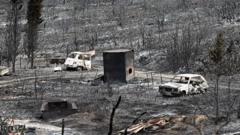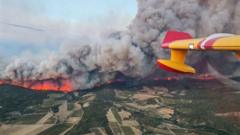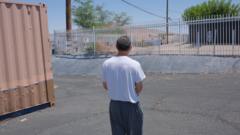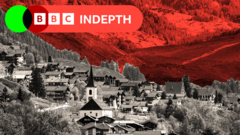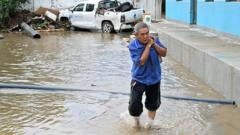A fast-moving wildfire, dubbed the Canyon Fire, has led to mandatory evacuations for over 2,700 residents in California as it expands drastically amid extreme conditions.
Canyon Fire Sparks Urgent Evacuations in California
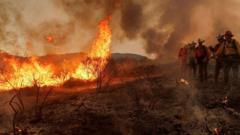
Canyon Fire Sparks Urgent Evacuations in California
Rapidly escalating wildfire conditions force thousands to flee their homes as firefighters struggle against extreme heat.
As the Canyon Fire continues to blaze northwest of Los Angeles, thousands are subjected to evacuation orders in response to its alarming spread and the rising threat from extreme heat. The fire ignited along the Ventura-Los Angeles County line on Thursday afternoon and rapidly grew from 30 acres to nearly 5,000 acres by Friday morning. Authorities from the Ventura County Fire Department stated that while more than 2,700 residents have been compelled to evacuate, an additional 14,000 have received evacuation warnings.
Firefighters have managed to gain partial control, with approximately 25% of the fire's perimeter contained. However, worsening weather conditions are complicating firefighting efforts. Forecasts from the National Weather Service imply soaring temperatures, expected to reach 100°F (37.7°C), will further exacerbate the situation.
Nearby residents in Santa Clarita are on high alert, with local officials urging them to heed evacuation warnings seriously. LA County Supervisor Kathryn Barger stressed the urgency on social media: "The #CanyonFire is spreading fast under extreme heat & dry conditions... when first responders say GO, leave immediately."
Fortunately, as of Thursday evening, there were no reported injuries or property damage. The Canyon Fire is one of several concurrent wildfires in California, with the Gifford Fire, which has engulfed nearly 100,000 acres across San Luis Obispo and Santa Barbara counties, being the largest.
California's increasing wildfire frequency is attributed to climate change, which has led to longer and more intense fire seasons. Recent events, such as the Eaton Fire earlier this year that claimed the lives of at least 31 individuals, highlight the growing threat of such disasters in the region. Experts continue to warn of the evolving dangers tied to California's changing climate, with more than 400 indirect deaths previously linked to LA wildfires, indicating a broader public health concern.
As the state battles these devastating conditions, community safety and preparedness remain paramount in the fight against wildfires.
Firefighters have managed to gain partial control, with approximately 25% of the fire's perimeter contained. However, worsening weather conditions are complicating firefighting efforts. Forecasts from the National Weather Service imply soaring temperatures, expected to reach 100°F (37.7°C), will further exacerbate the situation.
Nearby residents in Santa Clarita are on high alert, with local officials urging them to heed evacuation warnings seriously. LA County Supervisor Kathryn Barger stressed the urgency on social media: "The #CanyonFire is spreading fast under extreme heat & dry conditions... when first responders say GO, leave immediately."
Fortunately, as of Thursday evening, there were no reported injuries or property damage. The Canyon Fire is one of several concurrent wildfires in California, with the Gifford Fire, which has engulfed nearly 100,000 acres across San Luis Obispo and Santa Barbara counties, being the largest.
California's increasing wildfire frequency is attributed to climate change, which has led to longer and more intense fire seasons. Recent events, such as the Eaton Fire earlier this year that claimed the lives of at least 31 individuals, highlight the growing threat of such disasters in the region. Experts continue to warn of the evolving dangers tied to California's changing climate, with more than 400 indirect deaths previously linked to LA wildfires, indicating a broader public health concern.
As the state battles these devastating conditions, community safety and preparedness remain paramount in the fight against wildfires.




